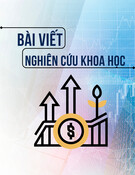
http://www.iaeme.com/IJM/index.asp
150
editor@iaeme.com
International Journal of Management (IJM)
Volume 8, Issue 2, March – April 2017, pp.150–160, Article ID: IJM_08_02_017
Available online at
http://www.iaeme.com/ijm/issues.asp?JType=IJM&VType=8&IType=2
Journal Impact Factor (2016): 8.1920 (Calculated by GISI) www.jifactor.com
ISSN Print: 0976-6502 and ISSN Online: 0976-6510
© IAEME Publication
IMPLEMENTATION OF JAN DHAN YOJANA –
CHALLENGES AND PROSPECTS
Dr. Rakesh K
Assistant Professor, Department of Mnagement Studies,
M V G R College of Engineering(A), Vizianagaram, India.
ABSTRACT
The intent of this study is to present a clear picture about how the PMJDY is being
implemented in Andhra Pradesh and north coastal Andhra in particular so as to find
out the bottlenecks the program comes to face at the field level. While doing so the
potential threats to the implementation of PMJDY alongside the characteristics of
population in north coastal Andhra Pradesh are to be studied in detail. Indeed
PMJDY is a program scrupulously designed to help the poor and the backward get
their share from government without intervention of any middlemen aimed at the
financial inclusion of people at the lowest rung. According to Reserve bank of India,
Financial inclusion is the process of ensuring access to financial services and timely
and adequate credit availability to the vulnerable groups such as weaker sections and
low income group at affordable cost. Planning commission (2009) further explain it as
universal access to a wide range of financial services at a reasonable cost. C
Rangarajan (2009) defined financial exclusion as restricted access to financial
services to certain segment of economy which includes individuals or family belonging
to low income group who cannot access basic banking like bank accounts, credit.
Key words: PMJDY, financial inclusion, Planning commission, financial services,
weaker sections.
Cite this Article: Rakesh K, Implementation of Jan Dhan Yojana – Challenges And
Prospects. International Journal of Management, 8 (2), 2017, pp. 150–160.
http://www.iaeme.com/IJM/issues.asp?JType=IJM&VType=8&IType=2
1. INTRODUCTION
According to reserve bank of India, financial inclusion is a process wherein access to financial
services is ensured with timely as well as sufficient availability of credit to the vulnerable
groups as weaker sections and low income groups at an affordable cost. Planning commission
(2009) further explains it as universal access to a wide range of financial services at a
reasonable cost. In 2009 C. Rangarajan depicted that financial exclusion is a kind of
restricting access to financial services for a particular section of economy that includes
individuals or family related to low income group who cannot reach basic banking such as
accounts, credit, insurance, financial advisory as well as payment services.

Implementation of Jan Dhan Yojana – Challenges And Prospects
http://www.iaeme.com/IJM/index.asp 151 editor@iaeme.com
So far the fruit of PMJDY has not completely reached the target crowd though it held a
greater promise for it is more widespread with greater benefits and technologically better than
its predecessors. The problem is not confined only to Andhra Pradesh but a major part of
India experiences the same. The study area is north coastal Andhra Pradesh because the three
districts in this region are mostly backward as revealed from survey of Andhra Pradesh in
2015. The following table gives us all the requisite details for why north coastal Andhra
Pradesh is chosen for the study.
Table 1.
S.
No District Total Post Offices
No. of
Bank
Branches
Deposits
(in Crore)
% of Rural
Population
% of ST
population
1 Srikakulam 558 278 6177.12 83.8 6.1
2 Vizianagaram 690 285 5581.59 79.1 10
3 Visakhapatnam
679 700 34675.58 52.5 14.4
4 East Godavari 851 724 18229.16 74.5 4.1
5 West Godavari 758 572 13138.77 79.5 2.8
6 Krishna 826 753 25745.38 59.2 2.9
7 Guntur 858 738 19839.4 66.2 5.1
8 Prakasam 925 439 9153.75 80.4 4.4
9 SPS Nellore 779 397 9462.06 71.1 9.7
10 YSR 833 358 9350.85 66 2.6
11 Kurnool 768 439 10956.72 71.6 2
12 Ananthapuram 942 438 13647.18 71.9 3.8
13 Chitoor 900 558 29857.5 70.5 3.8
Source: Population Census (2011), Chief Postmaster, General Finance (Institutional Finance)
Department
2. CONCEPTUAL FRAMEWORK
Though inclusion is old, coming up with a new name “PRADHANMANTRI JAN DHAN
YOJANA” gave some eagerness and vitality. PMJDY is a plan declared by our Prime
Minister "Sri Narendra Modi" on August fifteenth and dispatched in brief time by August
28th by opening more than 1.5 crore financial balances on single day. The plan is of its kind
with numerous elements such as having Rs. 1,00,000 accident cover, 30,000 insurance and
access to universal banking. Promoting financial literacy is the main objective of the
government so, that the transparency can be understood to the common man. The scheme of
its kind with diversified features as follows:
• Interest on deposit.
• Accidental insurance cover of Rs.1.00 lac
• No minimum balance required.
• Life insurance cover of Rs.30,000/-
• Easy Transfer of money across India
• Beneficiaries of Government Schemes will get Direct Benefit Transfer in these accounts.
• After satisfactory operation of the account for 6 months, an overdraft facility will be
permitted

Rakesh K
http://www.iaeme.com/IJM/index.asp 152 editor@iaeme.com
• Access to Pension, insurance products.
• Accidental Insurance Cover, RuPay Debit Card must be used at least once in 45 days.
• Overdraft facility up to Rs.5000/- is available in only one account per household,
preferably lady of the household.
The current status of PMJDY is shown in the table.
Table 2 All Figures in Crores
Bank Name RURAL URBAN TOTAL
NO OF
RUPAY
CARDS
AADHA
AR
SEEDED
BALANCE IN
ACCOUNTS
% OF ZERO-
BALANCE-
ACCOUNTS
Public
Sector
Bank
11.43 8.93 20.36 15.72 11.34 36403.85 23.37
Regional
Rural Bank 3.71 0.60 4.31 2.94 2.00 7630.75 20.26
Private
Banks 0.53 0.31 0.84 0.78 0.36 1602.01 36.27
Total 15.67 9.84 25.51 19.44 13.69 45636.61 23.27
Source: http://pmjdy.gov.in/account
3. REVIEW OF LITERATURE
In order to clearly understand the gravity of the topic of these research paper an extensive
review of various reports, white papers, dissertations and academic journals were reviewed. A
few of them have been listed below:
According to Dan Radcliffe and Rodger Voorhies, Bill & Melinda Gates (2012) poor’s
immersion in physical cash creates considerable frictions in their financial lives. Cash is
considered to be advantageous due to highly liquid however idle cash carries opportunity cost,
storage cost, storage risk, transport cost. The study suggested the many developed countries
pension saving rate is high when saving is the default option via automatic enrollment in
pension.
Charan Singh et.al. (2014) Reserve bank of India and Governement of India initiated
many measures since 2005 but many measures produced unsatisfactory results. Mobile
banking, banking technologies, Indian post office, fair price shops and business
correspondents are the key resources for to provide financial inclusion facilities in efficient
and user friendly ways.
Garg, Agarwal (2014) categorized initiatives taken by government and RBI into various
approaches which includes Product based approach to financial inclusion includes no-fill
accounts, Kisan credit card, general purpose credit card, saving account with overdraft
facility; bank lead approach includes SHGs and Business correspondents; regulatory approach
includes KYC, Bank branch authorization; Technology based approach includes mobile
banking, branchless banking, kiosk, Aadhar enabled payment services and Knowledge based
approach includes financial stability development council and financial literacy centers.
The Brooking report by John d. Villasenor, et.al. (2015) made a comparative study of
developing countries in terms of financial inclusion services and their penetration around the

Implementation of Jan Dhan Yojana – Challenges And Prospects
http://www.iaeme.com/IJM/index.asp 153 editor@iaeme.com
globe. The results showed Kenya, South Africa, Brazil, Rwanda /Uganda, Chile, Colombia
and Turkey to be the highest performing countries in terms of financial inclusion. They also
analyzed that digital financial services will accelerate financial inclusion in the years to come.
Global Financial Development Report (GFDR, 2014) the proportion of individuals and
firms that use financial services varies widely across the world, the report suggested that more
than 2.5 billion adults or half of the world’s adult population do not have access to bank
accounts. The major reasons behind this are no demand for accounts and other barriers like
cost, travel distance and increased amount of paper work. It could thus be concluded from
literature that developed and developing countries are taking steps towards financial inclusion
however developing countries still have proportionately higher number of financially
excluded people. Overcoming this barrier will help reduce poverty, generate savings, improve
flow of credit and thus will contribute to development and growth of economies.
Patnaik BCM, Satpathy I &Supkar A (2014) - This study is an attempt to understand the
hopes and expectation of the customers of the Odisha Gramin Bank (OGB). The authors have
taken note of the reforms initiated by the Government of India but to what extent the
aspirations of the customers are being taken care is the present issue discussed in this paper.
In this study the authors have tried to include the views 281 respondents and have considered
12 hypotheses. Two hypotheses were rejected by the respondents. The reasons seem to be the
more and more nationalized banks’ presence in the rural area. The authors believe that if the
intentions are good then the results will be definitely a positive one.
Kunthia R (2014) - The author in this research paper has attempted to study the recent
developments on Financial Inclusion in India with special reference to the recently launched
“Pradhan Mantri Jan-DhanYojna (PMJDY)”.The author has presented an analysis of its
different important areas, the roadblocks in the process and has suggested strategies to attain
universal coverage of the PMJDY for the underprivileged population and the large unbanked
areas of the country.
Sumanthy M (2013) - By ignoring the underprivileged and the disadvantaged is never
going to develop India as a nation in a remarkable way. The banks have shown a growth in
both volume and complexity as well as improvements in financial viability, competitiveness
and profitability, but still they have not been able to bring a vast segment of the population,
particularly the underprivileged sections into the bracket of basic banking services. An all-out
and serious effort is required to be made to eradicate financial exclusion as it can lift the
standard of living and provide opportunities to the poor and disadvantaged. Aggressive
policies need to be introduced with proper regulatory framework and consumer education so
that it does not lead to a situation of a financial crisis.
Bhuvaneshwari P &Pushpalatha P (2013) - The authors say that even after attainment of
independence India is yet to provide independence to its poor from debt and cunning money
lenders. The authors are of the view that the Indian banking system has to increase its focus
on the problems faced by rural India. The authors advocate the concept of social banking
which primarily constitutes financial services that result in human development; it is a system
in which the rich subsidises the provision of the financial services to the poor. Social banking
exists in India in the form of cooperative banks, regional rural banks but their success has
been limited due to the combination of a large population, the vast geographical spread of the
country & unavailability of banking services. They feel that social banking can be an
instrument of financial inclusion in India.
Dangi N & Kumar P (2013) - An inclusive financial system helps in improving the
standard of living and financial condition of the poor and the disadvantaged population in a
society. In this research papers the authors have focused on the various initiatives and policy
measures taken by the Government of India and the Reserve Bank of India for implementing

Rakesh K
http://www.iaeme.com/IJM/index.asp 154 editor@iaeme.com
financial Inclusion, its current status and future prospects. The authors conclude that despite
various policy and technological changes implemented in the road for achieving 100 %
Financial Inclusion, a large section of the population is still deprived from access to
affordable and appropriate financial services. The focus should be on creating financial
literacy, conducting training and education programmes on Mobile banking and e - banking.
Moreover the banks should take financial inclusion as a business initiative rather considering
it as a social initiative.
Sinha A (2013) - The author has commented on the occasion of the launch of the financial
inclusion programme of Cosmos bank that without overall financial inclusion , both financial
stability and inclusive growth cannot be reached. Banks need to look at financial inclusion as
a business model that can generate profits and not as an obligation which they need to fulfill.
In order to make financial inclusion as a successful business model, the banks have to focus
on lowering the costs of transactions by leveraging technology and offering more products of
credit to the already included population. The author finally concludes that the Urban Co-
operative banks have the potential to complete the objectives of financial inclusion.
According to SonamKumari Gupta (2015) accounts opened at public sector banks (PSBs)
under the Jan DhanYojana, 71 per cent are zero-balance, against 64 per cent for private banks
and as per the data released by ministry, only 28 per cent of the accounts opened under the
scheme are active, with about Rs. 9,000 crores deposited in these.
Harpreet Kaur &Kawal Nain Singh (2015), studied the recent trends in financial inclusion
in India with special reference to Pradhan Mantri Jan DhanYojana (PMJDY), highlighting its
key areas and suggested strategies to ensure maximum financial inclusion for the
disadvantaged and unbanked areas.
Divyesh Kumar (2014), discussed the overview of financial inclusion using PMJDY
scheme in India. It is revealed that, it is the greatest step ever taken to eradicate poverty is
financial inclusion through PMJDY. It is suggested that, the success of this scheme constant
review and regular check is very much essential.
Barhate and Jagtap (2014) focused on financial inclusion, strategy of PMJDY and issues
related to the success of the scheme. They concluded that every new thing requires
determination and attitude towards success path. They also concluded that to withstand the
heat of economic down surge and fight poverty, the Jan DhanYojana is good mechanism.
Rangarajan Committee (2008), defined financial inclusion as the process of getting an
access to financial services and timely and adequate credit at an affordable price when needed
by weaker sections of the society.
Leyshon and Thrift (1995) underpinned financial exclusion as phenomenon that resulted
from such processes that prevented specific groups from getting an access to formal financial
system.
Sinclair (2001) further supported the above saying that financial exclusion results from the
inability to get an access to financial services Again, Financial Exclusion could be the result
of supply side inefficiencies or it could come from the demand side altogether. It could be due
to reasons such as high costs, distance factor, economic conditions and so on.
Beck, Demirguc-Kunt& Martinez Peria (2007), Honohan (2007), and CGAP (2009) in
similar studies pointed out that word bank has been very active in attempting to gauge the
relevant parameters having an impact on the access to the financial services in developing
countries. Further, they attempted to deduce a relationship between access to financial
services and financial system development and economic development. It was found that
savings play a crucial role determining the investment level in economy and is directly linked
to growth.


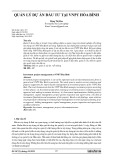

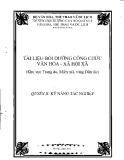

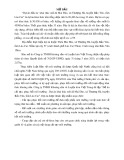
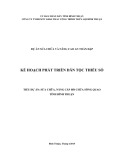
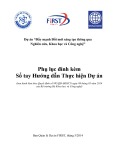
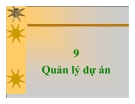

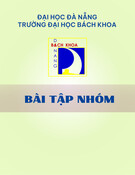






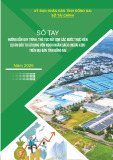
![20 câu hỏi Quản lý dự án phần mềm có đáp án [mới nhất]](https://cdn.tailieu.vn/images/document/thumbnail/2025/20251003/hieu2004haha@gmail.com/135x160/78791759734259.jpg)
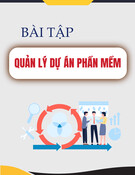

![Tài liệu Quản lý dự án: Kiến thức nền tảng toàn diện [chuẩn SEO]](https://cdn.tailieu.vn/images/document/thumbnail/2025/20250910/kimphuong1001/135x160/92631757496585.jpg)


